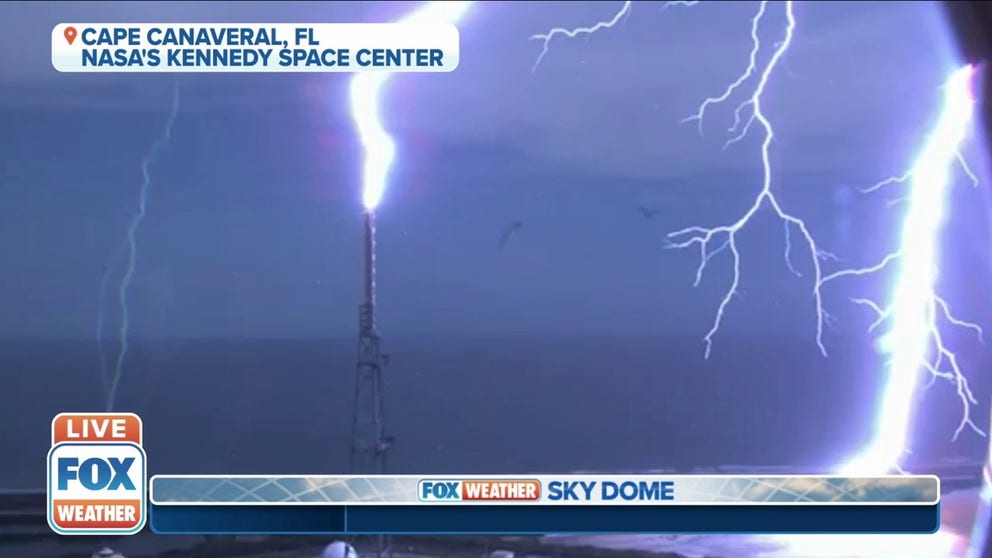ULA rocket finds enough clearing to launch in Florida's stormy weather pattern
Lightning protection system can divert electrical surge from 194-foot rocket

The ULA Atlas V rocket at Launch Complex 41 at Cape Canaveral Space Force Station. (Image: ULA)
Launching a rocket during Florida summer thunderstorm activity is always a challenge, which is why launch pads at Cape Canaveral and Kennedy Space Center have protection for rockets standing stories tall above anything else for miles.
Weather has been problematic for United Launch Alliance this week as it tries to launch a mission for the U.S. Space Force.
The Atlas V is scheduled to launch the USSF-12 mission for the U.S. Space Force's Space Systems Command. The payload includes two experimental satellites, including a missile-warning satellite, that will be delivered 22,000 miles above Earth.
HOW TO WATCH FOX WEATHER ON TV
After the first attempt was scrubbed Thursday evening due to lightning around the Cape Canaveral Space Force Station launch complex, a second attempt on Friday appeared to be off to the same start.
The 2-hour launch window opened at 6 p.m. ET. and Launch Weather Officer Jessica Williams forecasted a 50% chance of favorable weather conditions at the start of the window which was expected to worsen to 20% later in the evening as storms approached.
But as unpredictable as Florida's storms are there was enough of a clearing to launch the rocket just after 7 p.m. and the launch team said they successfully got the Atlas V into space.
On Thursday about four hours before the launch window opened for ULA's Atlas V rocket scheduled to send a U.S. Space Force mission to orbit, lightning struck near the launch site causing all personnel to clear the area as preparations for liftoff were underway.
"Bird is clean, but we just had a lightning strike nearby," ULA CEO Tory Bruno tweeted around 2:20 p.m. "So, we’ll have to clear the pad for a little while, then resume. Everybody - think calm, lightning-free thoughts."
DEEP IMPACT: WHAT TO KNOW ABOUT ASTEROIDS AND WHEN WE SHOULD BE WORRIED ABOUT THEM
Thunderstorms cleared enough for fueling the rocket with supercold propellants to get underway, however, shortly before the launch window was set to open the range was "red" due to lightning within 10 miles and cumulus clouds.
Weather thwarted Thursday's launch, but the team will retry the attempt on Friday around 6 p.m.
Williams said Thursday that weather challenges around the Cape for the launch would be a battle between the seabreeze and a weather system moving northwest of Florida's east coast. A similar pattern of thunderstorm activity along the coast will be the same problem on Friday.
Rockets can trigger lightning during a launch if certain clouds are near the launch site, which is why launch forecasters monitor cumulus and anvil clouds in the area.
NASA’S MEGA MOON ROCKET SURVIVED THE MOST POWERFUL LIGHTNING STRIKE EVER RECORDED AT SPACE CENTER
At 194 feet tall, the Atlas V is a target for lightning as storms roll through. Launch Complex 41, like all launchpads on the Space Coast, is equipped with a lightning protection system with tall steel masts around the rocket that can divert electrical current from the rocket and carry it safely into the ground.
NASA's mega moon rocket survives most powerful lightning strike ever recorded at space center
The most powerful lightning strike ever recorded at NASA’s Kennedy Space Center recently put the Florida spaceport’s lightning protection system at Launch Pad 39B to the test.
Recently, the lightning protection system at launchpad 39B, where NASA's Space Launch System rocket was standing tall, helped the mega moon rocket survive the strongest lightning strike ever recorded at Kennedy Space Center.
CLICK HERE TO GET THE FOX WEATHER UPDATE PODCAST
Cameras captured the exact moment the bolt hit one of the 600-foot-tall lightning protection towers around the launch site. The SLS and Orion spacecraft were unharmed because the protection system worked as designed.
The company that makes the lightning protection system, Scientific Lightning Solutions, said after more than 30 milliseconds, almost 3,000 amps were still flowing through the ground.
NASA says less than 5% of all cloud-to-ground strikes account for positive strikes.
